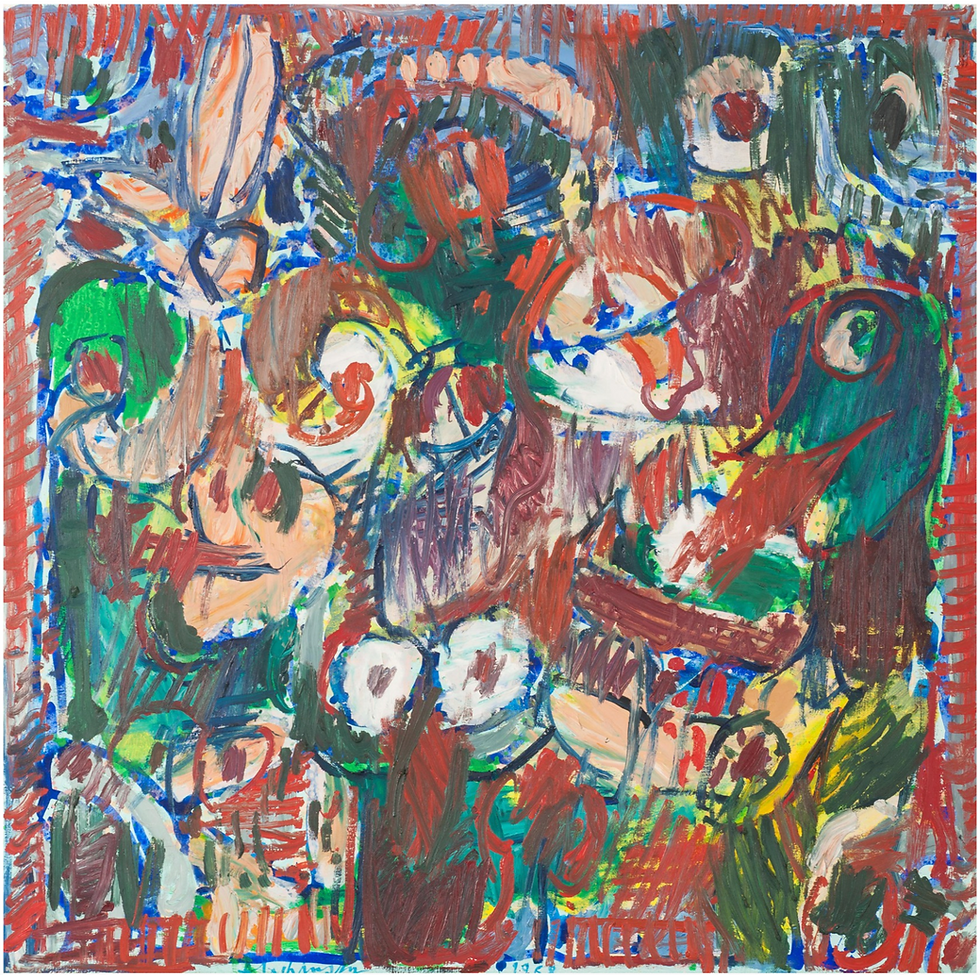The Existential Color of Natalie Westbrook
- Patrick Theimer
- Jun 18
- 4 min read

One of the best spots to stand in the Carnegie Museum of Art is anywhere in the CoBrA room, a gallery dedicated to "a resolutely independent European artist group founded in Paris and known as CoBrA, a name that combines the first letters of the founders’ home cities of Copenhagen, Brussels, and Amsterdam. Active from 1948 to 1951, the loose-knit group of poets and painters was united by their experience living under Nazi occupation and driven by a desire to reinvent art, free of all trappings of the past." Pittsburgh is forever linked to these artists in many ways, but few are as consequential as the 1977 Carnegie International Series featuring Pierre Alechinsky in its first single-artist exhibition. That was an event attended by a then 19-year old Keith Haring, and Haring describes the encounter in the 2005 John Gruen essay "Conversation with Keith Haring":
"I went to that exhibition I don’t know how many times. I bought the catalogue, I read Alechinsky’s writings. I watched the videos of him painting these enormous canvases on the floor! For him, it was like an Eastern thing, with the importance of gravity having great meaning. And he had rigged up these boards in his studio so he could lie on top of them in order to get to the middle of these big paintings on the floor. Well, Alechinsky totally blew me away. From that point on, it changed everything for me.

Right away my work started getting bigger and bigger. I found a place to get paper where they had cardboard tubes, leftover pieces from Styrofoam cuttings, and rolls of paper from printing plants. I’d haul the paper to the arts and crafts center and, after work or during lunch breaks, I’d be doing these paintings inspired by Alechinsky. I began working on the floor. The drips from the paint would be incorporated into what I was doing. My things were different from Alechinsky. They didn’t have the fluidity of his abstract line. Mine had a boxy edge to the line – a sort of constrained look, but still liberated.
The main thing that I was acquiring was confidence. I felt I was doing something that was worthwhile."
Stroll into Zynka to see the latest show featuring Natalie Westbrook and you will be transported to that very same spot in the Carnegie (which happens to be just a few miles away). And then walk up to Unseen Pearl on the wall and discover one of those worthwhile things. Reinvented. Liberated. Free.

Unseen Pearl dates back to 2011, and it seems to have been a sort of genesis for Natalie. There's an entropic exuberance to it, a sense of boundless discovery, raw and entangled. It's an important beginning within Natalie's oeuvre and the most CoBrA-esque painting in the show (not to imply that was its influence, or its intention). From there you will see bits of it in just about every other painting on view.
Similar to Haring, Natalie leans on a number of repeated and reshaped motifs in her work. Especially cats. And I learned recently that cats are believed to have dichromatic vision, which means they are limited to just two primary colors, reportedly blue and yellow... which means reds and pinks and purples are not in their range. I don't know why I know this. But while I was working my way through the gallery, a friend next to me confessed an aversion to the color pink. I looked around. There's a lot of pink. And I'm sure my reaction was obvious because she quickly noted how much she still liked the paintings because the pink wasn't really so pink... as though you had to really know pink to see pink if pink was what you wanted to see. And then I thought, maybe she's seeing pink the way a cat would see pink. It's still there. But it's not.
So then I started to see if I could look at the other colors in the same way -- the blues not blue, the greens not green, and so on. I couldn't do it. But it did change my focus. Color became more about time and sequence than structure or shape. I started to wonder which colors were there first and which were last, whether or not spontaneity was compromised by color, could color actually slow things down. Color became a time warp.
I am a cage, in search of a bird. ~ Franz Kafka
It was then I realized I had seen some of these paintings before. But not in color. Some had once lived in a largely monochromatic greyscale that is also a Westbrook signature (and something I really love). And that's when I learned at least two of the paintings had recently had color added as a sort of second life. A metamorphosis. That's very Kafka, which is very CoBrA. It was all making sense.

There's a momentariness to Natalie's paintings, as though what you see might change the next time you see it, and that could be just a blink or a glance away. Or not at all. Maybe because they seem spontaneous enough to keep going, or curious enough to get in your way. But you will come back to these paintings and swear you're seeing something you hadn't seen before. And then you start to question what you last saw. That's when you really see the color, mirrored in the moment's reflection and forever rooted to its time stamp. Or at least until you look again and challenge the way you want to see it now, or the way you saw before.
Maybe it did change. Or maybe its just you.
Catch Natalie Westbrook at Zynka Gallery from June 14 - July 19, 2025, resolutely recommended!!




Comments